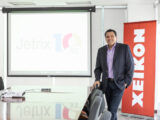Ravenwood Prepares for Global Growth
December 2, 2020Although a near global lockdown due to Covid-19 did initially provide something of a challenge for Ravenwood Packaging in terms of providing after sales service and support while travel was restricted, it has nevertheless proved to be a busy and successful year so far for the growth of the company’s linerless label technology, as well as for ongoing innovation and further global expansion.
In a conversation with Paul Beamish, Ravenwood’s founder and managing director, he was proud to announce the latest installation – bringing the company up to 30 to date – of the Com500 linerless coater into Skipnes Etikett in Trondheim, Norway’s largest label producer, as well as the establishment of a Ravenwood Packaging company in Australia to support the growth of linerless technology in the country, as well as in New Zealand and Asia.
‘With our own set-up in the United States, continued growth in Europe, and now extending into Australasia,’ says Beamish, ‘we are now significantly advancing a linerless label technology, that was primarily created for a changing developed world, into new markets and opportunities in fast-changing and developing countries where food distribution and retailing is moving more and more to pre-packed and chilled goods.
‘This ongoing global expansion in linerless technology has all been complemented with our expanding global network of machinery distributors and printer partners that has been growing year-on-year – currently covering some 44 printers and distributors, between them supplying and servicing some 20 countries – while in terms of actual linerless label products, we can now lay claim to billions of labels being produced and supplied worldwide through our technology each year.’
Emerging demand
The latest Com500 Coater installed at Skipnes Etikett in May this year was to
meet emerging demand for linerless in Norway and Scandinavia, mainly due to the
cost saving and sustainability benefits. With four linerless customers
producing meat, fish and poultry products already, Skipnes is aiming to
increase this to ten customers by the end of the year.
Another fast-emerging market for linerless, and one that is rapidly gaining in popularity, is the USA, where Ravenwood now has its own operation.
US-based print specialist Catapult Print has also recently invested in a Ravenwood Com500 Coater, adding linerless technology to its packaging and labeling facility in Orlando, Florida, including associated distribution centers, to capitalize on a market in which linerless was fast becoming the label of choice for many fresh and frozen food manufacturers and brand owners.
Catapult Print, which also specializes in self-adhesive and narrow web film, was formed in April 2018, with Mark Cook, founder and CEO, deciding to add linerless to the company’s product portfolio from the very outset to meet increased adoption of food safe packaging formats that reduce food spoilage, and to derive a point of difference by delivering stand-out products on shelf.
‘Typical linerless label applications today include meat, fish, chilled products, ready meals, fresh vegetables, pizza, salami, tubs, bakery and bottles,’ adds Paul Beamish.
‘The backs of these labels can often feature additional information, such as recipes, money-off coupons and promotions, including skin packs and super protruding food products. Linerless allows brand guardians more opportunity to communicate with shoppers, as there is more space to tell a story.
‘Converters with our Com500 machines have a dedicated coating system that runs and delivers high quality Ravenwood linerless labels to the correct specifications required for applying labels to food stuffs using Nobac applicator machines. Com500 machines are of a modular construction with the ability to simultaneously apply silicone and hotmelt adhesive to pre-printed labels, resulting in a linerless label.’
One of the key aspects of linerless labels that adds to the label’s overall performance is that the adhesive and the silicone release coating are applied to the face of the label after printing, and then only added where the design requires. The release coating on the label face acts as a protective coating for UV, moisture and chemical resistance, adding to a label’s longevity. By utilizing the face and the back of the label it means that end-users get more space to feature information – great for driving engagement and providing a competitive edge when products need to stand out on the shelf.
Unlike traditional self-adhesive labels where printing on the adhesive can act as a deadener and affect performance, linerless labels are virtually adhesive-free on the reverse so offer two selling faces. It is also possible to apply sleeves around packs using only two or three glue lines, each usually only 12mm wide. Eliminating the release liner carries many benefits: less waste, reduced landfill disposal costs and a much-reduced carbon footprint. Linerless is overall a more environmentally friendly and sustainable process of labeling.

